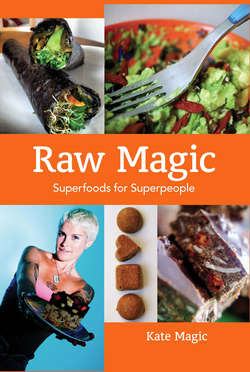Читать книгу Raw Magic - Kate Magic - Страница 14
На сайте Литреса книга снята с продажи.
ОглавлениеGojis
In the UK, 2006 was the year of the goji berry.
It became the latest fad trend, mentioned in the same breath as a list of skinny A-list celebrities, flying off the shelves of Fresh & Wild, the subject of BBC News articles. So is there anything behind the hype? Are goji berries just overpriced raisins? The Chinese have been eating gojis for over 2,000 years, and are mildly amused at our sudden “discovery” of what is to them an everyday food. The Chinese consume gojis in many forms: they add them to rice and meat when cooking, they make them into wine, and they are a popular tea. In the West, they are more commonly consumed as a snack, either on their own or in bars and trail mixes, or in the form of juice (although most products marketed as goji juice actually have a very low goji content). Like tomatoes, peppers and potatoes, they are a member of the nightshade family. I often substitute them for dried tomatoes in savory recipes as they have a similar intense, vivid flavor. They can easily be found in Chinese herbalists as well as health food shops, although the quality is variable. Generally, the more bright orange in color gojis are the more likely they are to have been sprayed with high levels of pesticides—the deeper red, the better.
The berries grow on shrubs, and those that grow in the Chinese Ningxia region are said to be very high quality. Here they grow along the floodplains of the Yellow River, renowned for its mineral-rich silt. This is likely to be why goji berries are said to contain monatomic trace elements and be high in ormus energy (see p. 67): they are grown in ancient, mineral-rich soil. So great is the popularity of gojis, and their contribution to the economy, that in Ningxia they hold an annual goji berry festival. The berries must be harvested carefully, and cannot be touched because that will cause them to oxidize and turn black. They are picked by hand, by shaking them off the bushes and onto mats where they are sun-dried or taken to factories for dehydrating.
Admittedly, there is some hype around goji berries in the West. In their dried form, they do not contain 500 times the vitamin C of oranges—fresh off the bush, maybe, but as anyone knows, vitamin C is very sensitive to heat and light and easily destroyed. Although they contain antioxidants that are known to prevent aging, it is unlikely that there are Chinese people who lived to be over 200 years old by eating them. Eating goji berries alone will not make you lose weight, although as part of a healthy diet they will fulfill your nutritional requirements and help you tune into your body’s natural appetite. But like all the superfoods in this book, they have a strong nutritional profile that assists the body in many different ways. And they also have that magical energetic quality, a “je ne sais quoi” which makes them uniquely irresistible. The Chinese say the only side effect of eating goji berries is laughing too much! I believe their popularity is largely down to the “have your cake and eat it” factor. Like cacao, gojis are fun. They taste like yummy little sweets, and you want to eat them, there is no element of chore or duty involved. But at the same time you are feeding your body one of the most nutrient-dense fruits on the planet, and giving yourself high doses of many vitamins, minerals and amino acids that you might be lacking.
In TCM (traditional Chinese medicine), goji berries are a yin food. They assist the liver and kidneys, enhance the immune system, and improve eyesight. Like ginseng, they are a tonic fruit, and nourish the heart and the internal organs. They are a valuable protein source, containing 18 of the 22 amino acids, including all eight essential amino acids, which makes them a great food for vegans, vegetarians, and developing children. They contain 22 minerals and trace minerals, thanks to the quality of the soil they are grown in. They are one of the best plant sources of iron and selenium, as well as containing significant amounts of calcium, potassium, and zinc. They are rich in vitamins, particularly the B group of vitamins, and exceptionally high in beta-carotene—more than carrots or apricots. It is the presence of carotenoids that gives them their reputation for improving eyesight. They are widely recognized for the amounts of polysaccharides they contain, which boost the immune system and reduce the risk of cancer. It is this combination of carotenoids and polysaccharides that make them such a valuable source of antioxidants. Contained in the seeds of the berries are significant amounts of omega-3 and omega-6 oils, the essential fatty acids.
Goji berries are associated with love, because of their bright red color, and the positive effect they have on the libido. Like cacao, they are a heart-centered food, so adding a few of them to any meal can help carry the qualities of all the other foods into our hearts. I wouldn’t say goji berries are particularly energizing in the same way that, for example, maca or pollen are. But they do provide us with a certain vitality, a ray of energy that no other foods provide. Because they are grown in one of the purest places on earth, the Himalayan mountains, they have a pure, high vibration that uplifts us, which is why they are known as the “happy berry.” It is this combination of being uplifting energetically and nourishing physically that makes them such a potent food. This humble little berry has the ability to simply add a little sunshine into your day (which is probably why they’ve caught on so much in the UK).
